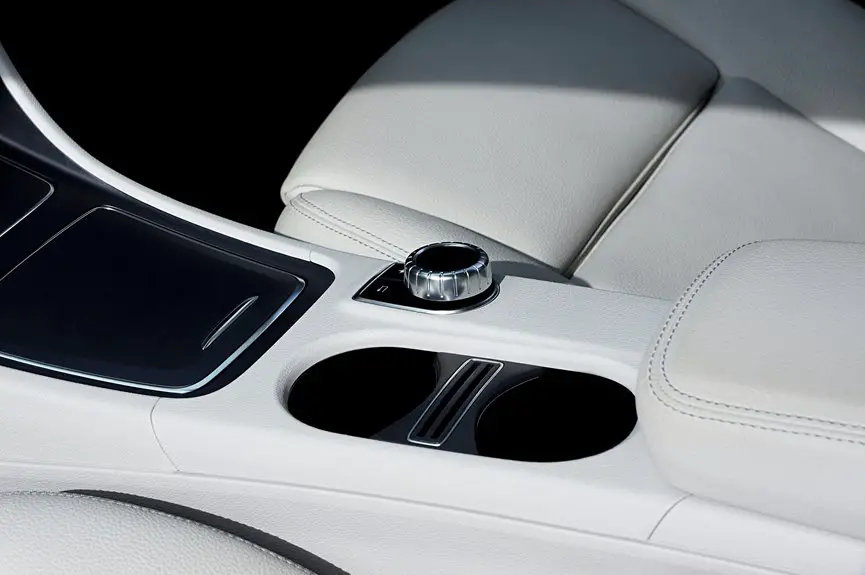You can replace your car’s interior by gathering essential tools like a staple gun, scissors, and adhesive, then choosing durable, comfortable fabric that fits your style. First, remove seats and old upholstery carefully, cleaning and preparing surfaces. Measure and cut your new fabric precisely, securing it tightly with hog rings or staples for a snug fit. With proper finishing and maintenance, your seats will look great and last longer. Keep going to uncover helpful sewing tips and detailed finishing advice.
Table of Contents
Key Takeaways
- Gather essential tools like staple gun, measuring tape, scissors, and spray adhesive before starting your car upholstery project.
- Choose durable, comfortable, and easy-to-maintain fabric such as cloth, leather, vinyl, or suede for your car seats.
- Safely remove seats and old upholstery, keeping screws and clips organized for smooth reassembly.
- Measure accurately, add seam allowances, cut fabric precisely, and secure it evenly using hog rings and pliers.
- Finish by smoothing wrinkles, reinforcing seams, trimming excess fabric, and maintaining upholstery regularly for longevity.
Tools and Materials Needed for Car Upholstery
To get started with car upholstery, you’ll need a handful of essential tools and materials that make the job manageable and professional-looking.
First, gather a staple gun with plenty of staples, as it’s vital for securing the fabric tightly. You’ll also want a set of screwdrivers and pliers to remove and reinstall seat components. A utility knife or sharp scissors will help you cut fabric accurately.
Start with a staple gun, screwdrivers, pliers, and sharp cutting tools to handle your car upholstery efficiently.
Don’t forget a measuring tape to guarantee precise dimensions. Foam padding or batting can improve comfort and appearance if the original padding is worn. Additionally, have a spray adhesive handy to bond layers securely.
Finally, keep some upholstery needles and strong thread nearby for any hand stitching needed. With these tools in place, you’ll be set to tackle your upholstery project confidently.
Choosing the Right Fabric for Your Car Seats
When picking fabric for your car seats, you’ll want to contemplate different types like leather, vinyl, or cloth.
Each material offers unique durability and maintenance needs that can affect how long your upholstery lasts. Understanding these factors helps you choose the best fabric for your lifestyle and car use.
Fabric Types Overview
Although selecting the right fabric for your car seats might seem overwhelming, understanding the key types available can simplify the process.
You’ll encounter several common options: cloth, leather, vinyl, and suede. Cloth offers breathability and comfort, making it ideal for everyday use. Leather gives a luxurious feel and classic look but tends to be pricier. Vinyl mimics leather but is more affordable and water-resistant, making it a practical choice.
Suede, while stylish and soft, requires careful handling due to its delicate nature. When choosing, consider how each fabric feels, looks, and fits your style. Knowing these basics helps you pick a fabric that suits your car’s interior and your personal preferences, setting you up for a successful DIY upholstery project.
Durability and Maintenance
Since your car seats endure daily wear and tear, choosing a fabric that stands up to use and is easy to maintain is essential.
Look for materials like leather or high-quality vinyl if you want durability and simple cleaning. They resist stains and can be wiped down quickly.
If you prefer fabric, consider tightly woven options like microfiber, which handle spills better and resist fading.
Avoid delicate fabrics that show wear quickly or require special cleaners.
Regular maintenance, such as vacuuming and spot cleaning, extends your upholstery’s life regardless of fabric.
Remember, the right choice balances comfort, style, and practical upkeep.
Picking a durable, low-maintenance fabric saves you time and effort while keeping your car’s interior looking fresh longer.
Preparing Your Car Interior for Upholstery Work
Before you start upholstering, remove the seats and panels to give yourself full access.
Take time to clean every surface thoroughly, so dirt doesn’t get trapped under the new fabric.
While you’re at it, inspect for any damage that needs fixing before you move forward.
Remove Seats and Panels
Start by carefully removing the seats and panels to give yourself clear access to the areas you’ll be working on.
First, disconnect the car battery to avoid any electrical issues. Then, use a wrench or socket set to unbolt the seats from their mounting points. Don’t forget to unplug any electrical connectors for seat heaters or airbags before fully removing the seats.
Next, remove door panels and trim pieces by locating and undoing screws, clips, or fasteners. Use a trim removal tool or a flathead screwdriver wrapped in cloth to prevent damage. Keep all screws and clips organized for reassembly.
Removing these components not only makes your workspace manageable but also prevents accidental damage to interior parts during upholstery replacement.
Take your time, and handle everything gently.
Clean and Inspect Surfaces
Although removing seats and panels gives you better access, you’ll want to thoroughly clean and inspect every surface before installing new upholstery.
Start by vacuuming all debris, dust, and dirt from crevices and corners. Use a mild cleaner suitable for your car’s interior materials to wipe down hard surfaces like plastic and metal.
Check foam padding for any signs of wear, mold, or damage; replace it if necessary. Inspect the underlying fabric and frame for rust, cracks, or loose fasteners.
Address any issues now to avoid problems later. Cleaning and inspecting carefully guarantees your new upholstery adheres well and lasts longer.
Taking this preparation step helps assure a smooth, professional-looking finish once you begin the reupholstering process.
Removing Old Upholstery Safely and Efficiently
When you remove old upholstery, take your time to avoid damaging the car’s interior. Start by carefully detaching any trim pieces, screws, or clips holding the fabric in place.
Use a flathead screwdriver or trim removal tool to gently pry components loose without scratching surfaces. Peel back the fabric slowly, watching for hidden fasteners or staples.
Gently pry components with a flathead or trim tool, peeling fabric slowly to reveal hidden fasteners or staples.
If staples hold the upholstery, use pliers or a staple remover to extract them carefully. Avoid ripping or pulling too hard, which can harm the foam or underlying panels.
Keep track of all hardware for reassembly. Dispose of old materials responsibly.
Measuring and Cutting New Fabric for a Perfect Fit
Measuring your car seats accurately guarantees a flawless fit for your new upholstery fabric.
Start by removing the old fabric completely to expose the seat’s shape and contours. Use a flexible measuring tape to note the length, width, and depth of each seat section, including bolsters and seams.
Add an extra 2-3 inches to every measurement to allow for seams and tucking. Lay your new fabric flat on a clean surface, then transfer your measurements using chalk or a fabric marker.
Cut slowly and precisely along the marked lines with sharp fabric scissors or a rotary cutter, avoiding jagged edges. Taking your time here assures the fabric will fit snugly without excess material bunching or stretching during installation.
Sewing Techniques for Upholstery Beginners
Now that you’ve cut your fabric to the right size, it’s time to focus on sewing techniques that will help you assemble your upholstery like a pro.
Start by using a heavy-duty needle and upholstery thread to handle thick materials. Use a straight stitch for seams, keeping stitches close and even to guarantee durability. Reinforce stress points with backstitching to prevent unraveling.
Use heavy-duty needles and thread, straight stitches, and backstitch stress points for strong, durable seams.
When sewing curves, sew slowly and gently guide the fabric to avoid puckering. Press seams open with a warm iron for a clean finish. If your machine struggles, consider hand stitching with a strong needle and thread.
Always test your stitches on scrap fabric first to adjust tension and stitch length. Mastering these basics sets a solid foundation for your upholstery project.
Attaching New Upholstery to Your Car Seats
Although attaching new upholstery might seem challenging, you can achieve a professional look by taking it step by step.
Start by aligning the fabric carefully over the seat, making sure to smooth out wrinkles as you go. Use hog rings and pliers to secure the fabric to the seat frame, clipping the rings tightly around the springs or metal edges.
Work from the center outward to keep tension even and prevent puckering. Don’t forget to trim excess material to avoid bulk.
Pay close attention to seams and corners, folding them neatly before fastening. Take your time to guarantee everything is taut and properly positioned.
With patience and careful handling, your new upholstery will fit snugly, transforming your car seats with a clean, fresh appearance.
Tips for Finishing Touches and Detailing
Once you’ve secured the upholstery, focus on finishing touches to elevate your car’s interior.
These details not only enhance appearance but also guarantee durability and comfort.
Here are key tips to contemplate:
- Smooth Out Wrinkles: Use a heat gun carefully to tighten fabric and eliminate creases.
- Secure Edges: Reinforce seams with extra stitching or fabric adhesive to prevent fraying.
- Clean Up Excess Material: Trim any stray threads or excess fabric for a polished look.
- Add Protective Coatings: Apply fabric protectors or conditioners to maintain texture and resist stains.
Maintaining Your New Upholstery for Longevity
To keep your car’s upholstery looking fresh and lasting longer, you’ll need to establish a consistent care routine.
Start by regularly vacuuming to remove dirt and debris that can cause wear. Wipe down surfaces with a microfiber cloth and mild cleaner suitable for your fabric or leather. Avoid harsh chemicals that may damage the material.
Regularly vacuum and gently clean upholstery with a microfiber cloth and mild cleaner to prevent damage.
For leather, apply a conditioner every few months to prevent cracking and maintain suppleness. Protect your seats from direct sunlight using sunshades or window tinting to reduce fading and heat damage.
Quickly address spills by blotting them immediately to prevent stains. Finally, avoid eating or drinking inside your car to minimize mess.
Frequently Asked Questions
How Long Does a Typical Car Upholstery Project Take?
Did you know the average DIY upholstery project takes about 10-15 hours? You’ll likely spend a weekend or two working steadily, depending on your skill level and the car’s interior complexity, so plan accordingly to avoid frustration.
Can I Use Automotive Upholstery Fabric for Outdoor Furniture?
You can use automotive upholstery fabric for outdoor furniture, but it’s not ideal. It’s designed for interiors and may not withstand prolonged sun or moisture exposure like outdoor-specific fabrics, so expect quicker wear and fading.
What Are Common Mistakes to Avoid in DIY Upholstery?
You’ll want to avoid using the wrong fabric, skipping measurements, and neglecting proper tools. Don’t rush the process or ignore padding quality. Taking your time and prepping well will save you headaches and guarantee better results.
How Do I Remove Odors From Old Car Upholstery?
Think of your car’s interior as a garden; odors are pesky weeds. You’ll want to sprinkle baking soda, let it sit overnight, then vacuum thoroughly. Fresh air and a vinegar spray can help clear the stale scent, too.
Is Professional Help Recommended for Complex Seat Repairs?
For complex seat repairs, you’ll want professional help. They have the skills and tools to fix intricate issues safely and efficiently, saving you time and preventing potential damage that might occur with a DIY attempt.
- Recycling Nonwoven Fabrics: Is It Possible? - July 11, 2025
- Recycling Nonwoven Fabrics: Is It Possible? - July 11, 2025
- Recycling Nonwoven Fabrics: Is It Possible? - July 11, 2025






